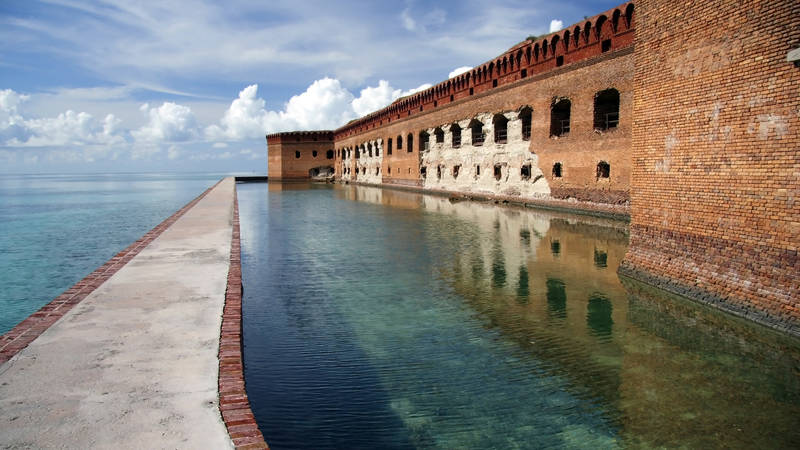A small, long-submerged island is revealing Civil War mysteries in Dry Tortugas National Park. The National Park Service is conducting an in-depth survey to learn more.
Maritime archaeologist Joshua Marano was conducting an aerial survey over the Dry Tortugas archipelago, 70 miles west of Key West, when he noticed an anomaly in the water. Subsequent digging through National Park Service and national archives revealed it must be a submerged island that was part of Fort Jefferson, the Civil War stronghold that is now a key attraction at Dry Tortugas National Park.
The small island is long gone. Barely more than a patch of sand, it eroded away from hurricanes and rising seas. But at one point it supported a military hospital and cemetery. When Marano and his team returned to the site on a dive, they expected to find foundations of the old buildings. But what they discovered, under just a few feet of water, was even more extraordinary.
“We ended up finding a large carved gravestone with a name and date they died on it,” said Marano, who is the project director for the survey. The name carved on it was John Greer, a laborer who died on Nov. 5, 1861. According to records, Greer is one of several dozen people buried there. The find is particularly unusual because even while the fort was active, storms washed away a number of grave markers.
Marano and his colleagues are preparing to do a more in-depth survey of the site, which likely contains American service members who did not get proper burials. Through their research, the team uncovered this writing from Lt. James M. Ingalls, 1st U.S. Artillery at Fort Jefferson, to Capt. William B. Hughes, Chief Quarter Master, Department of the Gulf, New Orleans, on April 18, 1873:
“…The graves are scattered about, without regular arrangement, and almost hidden by a dense growth of bay cedar. Three or four coffins were found uncovered. Occasionally Coffins are washed out to sea during a heavy blow. There is no cemetery at the Post deserving the name; and this is probably the only Post in the U.S. where a deceased Soldier cannot have decent interment.”
According to the historical research, the cemetery could also contain civilians. The Park Service says the population of Fort Jefferson had not only military personnel, but prisoners, enslaved people, engineers, support staff, laborers and their families.

The Imprisoned Doctor Who Helped Fight an Epidemic
A country doctor convicted in the plot to assassinate President Lincoln earned a pardon by treating an outbreak in his prison, which is now part of a national park.
See more ›After the Civil War, Fort Jefferson housed a prison, primarily for Union deserters — although, its most famous resident was Dr. Samuel A. Mudd, who was convicted of conspiring with John Wilkes Booth in the assassination of President Abraham Lincoln.
Beyond the cemetery, Marano hopes to discover what’s left of the hospital, which was in use from the 1860s until the 1890s. Its primary patients were those infected with yellow fever, which plagued the outpost during that time. However, that’s probably not what killed John Greer.
“We don’t know how he died yet,” Marano said. “But we assume it was something relatively traumatic because he didn’t show up in the hospital records as being sick. So, it was something that happened kind of quickly. A traumatic death may also explain why he had such an ornate grave marker compared to many others that were marked with wooden crosses or stakes, if anything at all.”
Another archaeological aspect that Marano finds rewarding is that even though this portion of Dry Tortugas has been surveyed before, it took until now to find this site.
“That’s the great thing about the Park Service,” he said. “We often promote in-situ preservation and document finds in place as new technologies or methodologies may allow us to have new research opportunities in the future. And Mr. Greer is a good example of that.”
Watch NPS video of the dive site
Stay On Top of News
Our email newsletter shares the latest on parks.
About the author
-
 Karuna Eberl Contributor
Karuna Eberl ContributorKaruna Eberl writes about wildlife, history and adventure from the sandbars of the Florida Keys and the high country of Colorado.